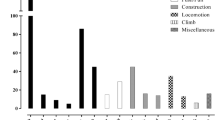Abstract
Firefighter turnout gear and equipment protect the wearer against external hazards but, unfortunately, restrict mobility. The aim of this study was to determine the ease of mobility and comfort while wearing a new prototype firefighter ensemble (PE) with additional chemical/biological hazard protection compared to a standard ensemble (SE) by measuring static and dynamic range of motion (ROM), job-related tasks, and comfort. Eight healthy adults (five males, three females), aged 20–40 years, participated in this study. The study consisted of two repeated phases, separated by five uses of the ensembles. Subjects randomly donned either the SE or PE in either dry or wet conditions on separate days. In each phase, five tests were carried out as follows: baseline (non-ensemble), SE-dry, SE-wet, PE-dry, and PE-wet. There was a significant reduction (P < 0.05) of wrist flexion for PE-dry condition compared to the same SE-dry condition. Donning the PE took 80 s longer than the SE in phase 1, this difference disappeared in phase 2. There was a significant decrease (P < 0.05) in post-test comfort wearing the PE compared to the SE. The data collected in this study suggest that, in spite of design features to enhance chemical/biological hazard protection, the PE design does not decrease the wearer’s overall functional mobility compared to the SE. However, subjects seem to be more comfortable wearing the SE compared to the PE. These overall findings support the need for a comprehensive ergonomic evaluation of protective clothing systems to ascertain human factors issues.


Similar content being viewed by others
References
American Society for Testing and Materials (2004) ASTM F 1154-99a, Standard practices for qualitatively evaluating the comfort, fit, function, and integrity of chemical protective suit ensembles. ASTM International, West Conshohocken
Barker R (2005) A review of gaps and limitations in test methods for first responder protective clothing and equipment. This report presents the results of a review aimed at identifying test methods for protective clothing for first responders, as well as identifying areas in which further research is required. Prepared by Dr. Roger L. Barker under contract number 254-2004-M-0594 with NIOSH. http://www.cdc.gov/niosh/npptl/pdfs/ProtClothEquipReview.pdf
Barker R, Myhre L, Scruggs B, Shalev I, Prahsarn C, Miszko T (2000) Effect of measured heat loss through turnout materials on firefighter comfort and heat stress. Part I: performance in a mild environment, Performance of protective clothing: issues and priorities for the 21st century: 7th Volume, ASTM STP 1386. In: Nelson CN, Henry NW (eds) American Society for Testing and Materials, West Conshohocken, pp 519–534
Goldman RF (2005) The four ‘Fs’ of clothing comfort. In: Tochihara Y, Ohnaka T (eds) Environmental ergonomics, vol 3, Elsevier, Amsterdam, pp 315–319
Guidotti TL, Clough V (1992) Occupational health concerns of firefighting. Ann Rev Public Health 13:151–171
Havenith G, Heus R (2004) A test battery related to ergonomics of protective clothing. Appl Ergon 35:3–20
Huck J (1988) Protective clothing systems: a technique for evaluating restriction of wearer mobility. Appl Ergon 19(3):185–190
Huck J (1991) Restriction to movement in fire-fighter protective clothing: evaluation of alternative sleeves and liners. Appl Ergon 22(2):91–100
Johnson S (2005) Ergonomics protocol for next generation structural firefighter personal protective equipment evaluation. Paper presented at the advanced personal protective equipment: challenges in protecting first responders meeting, Blacksburgh
National Fire Protection Association (2007) NFPA 1971 Standard on Protective Ensembles for Structural Fire Fighting and Proximity Fire Fighting, 2007 Edition. National Fire Protection Association, Quincy
Stull JO (2000) Issues and challenges in chemical protective clothing. Ergonomics of protective clothing, pp 222–225
Stull JO, Duffy R (2000) Field evaluation of protective clothing effects on fire fighter physiology: predictive capability of total heat loss test, Performance of protective clothing: issues and priorities for the 21st century: 7th volume, ASTM STP 1386. In: Nelson CN, Henry NW (eds) American Society for Testing and Materials, West Conshohocken, pp 481–503
Szczecinska K, Lezak K (2000) Review of research studies of ergonomics aspects of selected personal protective equipment. Int J Occup Safety Ergon, Special Issue, pp 143–151
Acknowledgments
We would like to thank Ms. Nicolette Shriver for her technical support during the experimental testing. We would also like to thank Mr. Edward Sinkule for his helpful suggestions and careful review of this manuscript. This study was partially supported by funding from Technical Support Working Group (TSWG). This research was performed while one of the authors (AC) held a National Research Council Resident Research Associateship at the National Personal Protective Technology Laboratory (NPPTL).
Author information
Authors and Affiliations
Corresponding author
Additional information
The findings and conclusions of this manuscript are those of the authors and do not necessarily reflect the views of the National Institute for Occupational Safety and Health. Mention of any company name or product does not constitute endorsement by the National Institute for Occupational Safety and Health.
Rights and permissions
About this article
Cite this article
Coca, A., Roberge, R., Shepherd, A. et al. Ergonomic comparison of a chem/bio prototype firefighter ensemble and a standard ensemble. Eur J Appl Physiol 104, 351–359 (2008). https://doi.org/10.1007/s00421-007-0644-z
Accepted:
Published:
Issue Date:
DOI: https://doi.org/10.1007/s00421-007-0644-z




